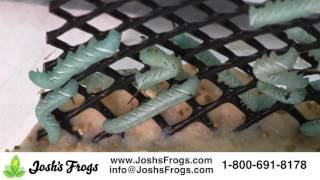
You might wonder why we’re focusing on hornworm predators—after all, isn’t that counterintuitive if we want hornworms for feeders? Here’s the thing: balancing the ecosystem in your garden or greenhouse can help prevent hornworm outbreaks. Predators like parasitic wasps, lacewings, and certain birds can keep these pesky caterpillars under control without harmful chemicals. Let me explain how you can create a hornworm-friendly habitat that attracts these natural allies.
Understanding Hornworm Predators
Before diving into how to create a friendly habitat, it’s worth taking a moment to understand who these hornworm predators are. Predators come in various forms, but for hornworms, specific insects and birds play crucial roles.
Parasitic wasps, for instance, are tiny heroes in the world of pest control. They lay their eggs inside hornworms. When the eggs hatch, the larvae consume the host—yikes, right? But that’s nature’s way of keeping things balanced. Then there’s the lacewing, another beneficial insect. Lacewing larvae are robust predators, munching on hornworms and many other garden pests. Birds, like warblers and sparrows, also love snacking on these caterpillars.
These predators not only help maintain the hornworm population but also support a balanced ecosystem in your garden. By encouraging their presence, you’re fostering a more resilient and healthy environment.
Choosing the Right Plants
Let’s talk plants. Creating a hornworm-friendly habitat for predators means choosing the right flora. You want to have a variety of plants that attract beneficial insects while also ensuring a food source for the hornworms. Think of it as building a buffet!
Here are a few plants to consider:
- Nasturtiums: These vibrant flowers attract lacewings and also serve as a trap crop for hornworms.
- Marigolds: Not only do marigolds bring color to your garden, but they also attract parasitic wasps.
- Fennel: This herb is a magnet for predators like ladybugs and hoverflies, which can help control hornworm populations.
- Sunflowers: These tall beauties not only look great but also attract a variety of pollinators and pest predators.
By planting a mix of these options, you’ll create a welcoming environment that draws in the hornworm’s natural predators while also maintaining a population of hornworms for your needs.
Creating Shelter and Nesting Areas
Just like humans, predators need shelter. Offering a safe space for insects and birds to rest or nest can drastically enhance your success in attracting them. Adding layers and diversity in your garden can help.
Consider these ideas for providing shelter:
- Dense foliage: Tall grasses or bushes create natural hiding spots, making it easier for birds to find safety and for insects to thrive.
- Insect hotels: These are simple structures made of wood or bamboo that offer nesting spots for beneficial insects.
- Mulch and ground cover: These layers provide habitats for ground-dwelling predators and moisture retention for the plants.
Adding structure and diversity to your garden not only supports the predators but also helps maintain a balanced ecosystem, reducing the need for chemical pest control.
Water Sources are Key
Even the smallest creatures need water. By including a reliable water source, you’re helping sustain the beneficial predators in your garden. A simple shallow dish filled with water, pebbles, or stones can do wonders.
Here’s how to set it up:
1. Choose a shallow container: A birdbath, bowl, or a small dish will work well.
2. Add pebbles or stones: This gives the insects a place to land without drowning.
3. Place it strategically: Position it near flowering plants where predators are likely to visit.
With this easy setup, you’re ensuring that the helpful insects and birds have access to drink, making your garden a more inviting space.
Avoiding Pesticides
One of the biggest threats to hornworm predators is pesticide use. It’s easy to think that chemicals will solve your problem, but they often do more harm than good. Many pesticides are non-selective, meaning they’ll kill off beneficial insects along with the pests.
If you want to create a thriving hornworm-friendly habitat, consider these tips:
1. Use natural pest control methods: Introduce beneficial insects, like ladybugs or lacewings, to combat pests without pesticides.
2. Practice good garden hygiene: Remove dead plants and debris, which can harbor pests.
3. Encourage biodiversity: A diverse garden attracts a variety of predators, which can keep your hornworm numbers in check naturally.
By avoiding pesticides, you’re fostering a healthy environment for your hornworm predators.
Monitoring Your Habitat
Creating a hornworm-friendly habitat isn’t just a set-it-and-forget-it process. You need to keep an eye on things and be proactive. Monitoring the balance of pests and their predators will help you understand what’s working and what might need adjustment.
Here are some monitoring tips:
– Regular checks: Look at your plants and the insects present. Are the hornworms being kept in check? Are your beneficial insects thriving?
– Take notes: Document your observations. This way, you can track what works and make changes as needed.
– Be patient and flexible: Nature takes time, and sometimes it involves trial and error. Be open to experimenting with different plants and habitats.
With consistent monitoring, you can adjust your strategies and optimize your garden for harmony between hornworms and their predators.
Final Thoughts on Cultivating Harmony
Creating a hornworm-friendly habitat for predators may take some time and effort, but the rewards are worth it. You’re not only managing pests naturally but also promoting a healthy, vibrant garden ecosystem that can thrive over the long term.
By focusing on a mix of plants, providing shelter, maintaining water sources, avoiding harmful chemicals, and regularly monitoring your space, you’re setting the stage for a flourishing environment. Remember, nature works best in balance, and with a little love and care, you can cultivate a space where both hornworms and their predators coexist beautifully.
So, grab your gardening gloves and get started—the plants and wildlife will thank you!
